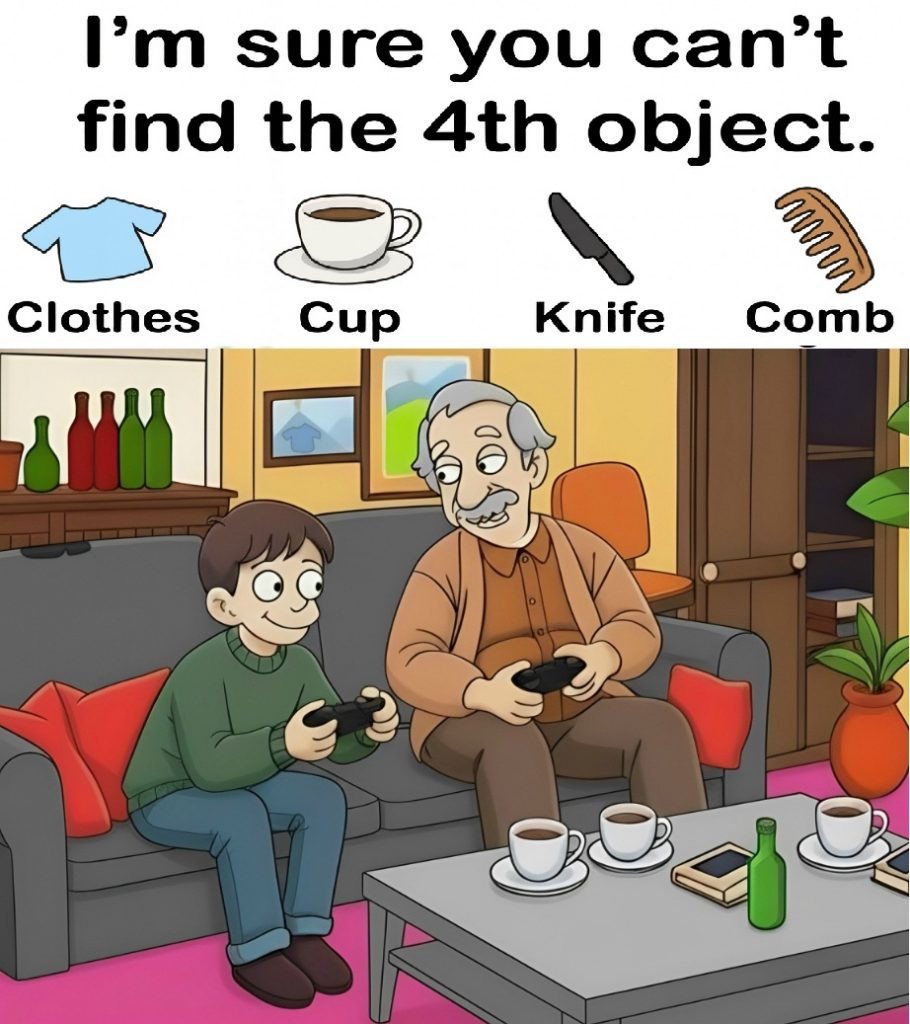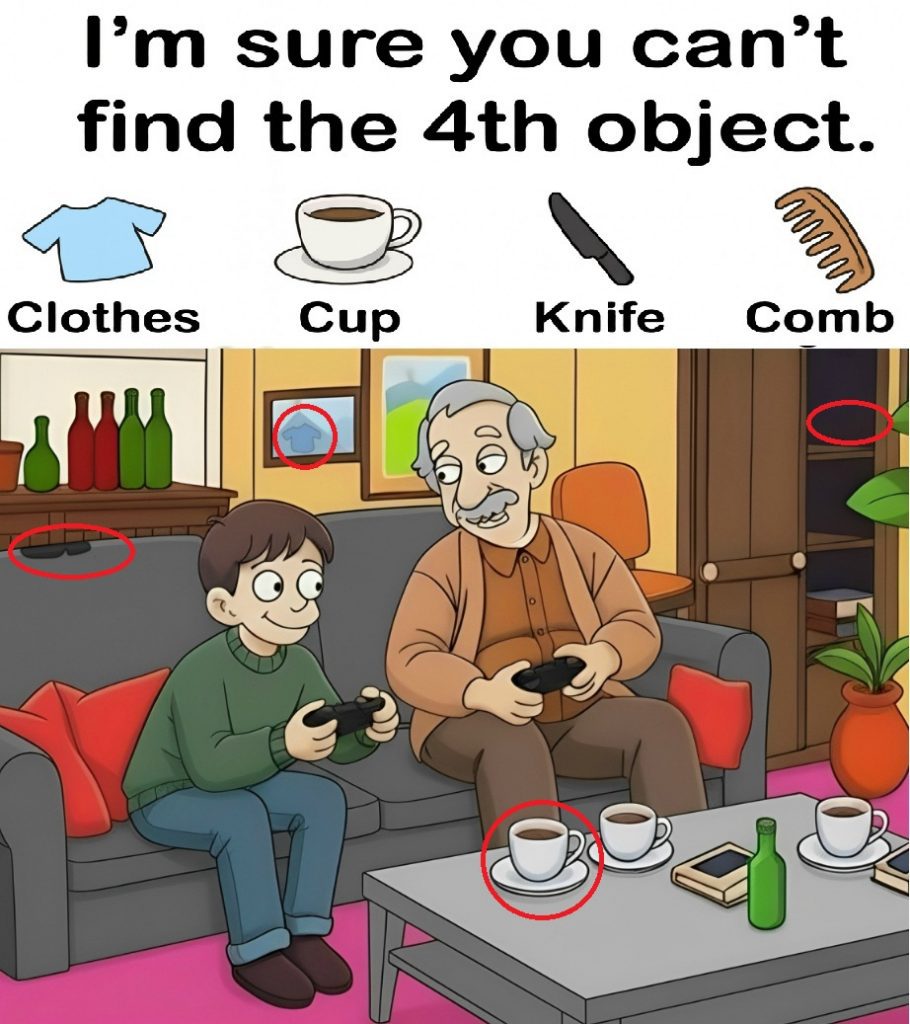Brain–teasing picture riddles are a fun way to slow down, sharpen your focus, and test how observant you really are. In this puzzle, we see a cozy living room scene: a boy and his grandfather are happily playing video games on the couch, surrounded by bottles, plants, books, and cups of coffee. Somewhere inside this peaceful moment, four hidden objects are waiting to be found: clothes, a cup, a knife, and a comb.
Before you keep reading, take a moment to really study the image. How many of the four items can you find on your own? Where would you hide a knife or a comb in such a warm, friendly scene? And which of the four objects do you think is the hardest to spot? Make your guesses first—then come back and see how close you were.
Why So Many People Miss The Hidden Objects
If you struggled to find all four items, you’re not alone. These puzzles are cleverly designed to use our own habits of seeing against us. There are a few common mistakes people make when solving this type of riddle.

1. Expecting objects to appear where they “should” be
When we hear “clothes,” we imagine a wardrobe, a hanger, or a laundry basket. When we think of a “knife,” we expect it near food or in the kitchen. This expectation makes us ignore other parts of the picture. But in a good puzzle, objects are rarely placed in the most obvious locations.
2. Focusing only on the main characters
Our eyes are naturally drawn to faces and people. In this image, we look at the boy, the grandfather, and their expressions. Because our attention stays on them, we often ignore the background elements like bookshelves, framed pictures, furniture edges, and decorative items—exactly the places where hidden objects love to hide.
3. Skimming instead of truly observing
Most people quickly glance across the image instead of scanning it slowly, section by section. Tiny details such as outlines, shadows, or small shapes get lost when we rush. The brain fills in missing information and tells us everything looks “normal,” even when something unusual is right there.
4. Forgetting that objects can be stylized or merged
We expect a comb to look exactly like the comb icon at the top of the puzzle, and a knife to have a shiny blade and a sharp tip. But artists often merge the hidden object with something else, changing its color or shape just enough to camouflage it. If we don’t consider that possibility, we walk right past the solution.
Once you understand these traps, you can use a more systematic approach. Let’s do that now and uncover every hidden object one by one.
Video : 💯 sure u can’t find the 4th object!
Step-By-Step Guide To Solving The Puzzle
We’re going to search the picture carefully, from the background to the foreground, and reveal how each object is disguised.
1. Finding the Clothes
Look at the wall behind the grandfather. There are framed pictures hanging there. In one of the frames, instead of a landscape or abstract art, you’ll notice the shape of a blue T-shirt. This is the “clothes” you are supposed to find.
At a quick glance, many people think it’s just a decorative shape or a random part of the artwork. But if you look closely, the outline clearly shows sleeves and a neck hole. The puzzle designer has turned the clothes into what looks like a simple wall painting, hiding it in plain sight.
So the first object—clothes—is hidden as a T-shirt inside the picture frame on the wall.
2. Spotting the Cup
Now shift your attention to the coffee table in front of the couch. There are several items on it: a green bottle, a phone, a book, and some cups on saucers. Among these, one cup stands out as the clearest example that matches the icon shown at the top of the puzzle.

The cup on the table, complete with handle and saucer, represents the second hidden object. You might think, “But that’s too obvious!” and that is the trick. Because the cup is openly visible, some people overthink and search for a more secret location. They assume the answer must be harder and ignore the simple solution right in front of them.
So the second object—a cup—is the clearly visible coffee cup on the table.
3. Discovering the Knife
This is where the puzzle gets much more clever. A knife feels dangerous in such a warm family scene, so your brain automatically assumes it cannot be there. It quietly stops searching for anything sharp.
Take another look at the edge of the boy’s seat on the couch. Look closely at the dark part of the sofa where he is sitting. The outline and angle of that section resemble the blade of a knife. The artist has shaped part of the seat so that it mirrors the silhouette of the knife shown above.
What looks at first like a simple dark line on the furniture actually forms a full knife shape when you focus on it. The handle blends into the seating, and the blade aligns with the cushion’s edge.
So the third object—the knife—is cleverly hidden as part of the boy’s chair.
4. Revealing the Comb
Finally, let’s search the right side of the picture. There is an open storage cabinet with shelves. On one of the upper shelves, you can see a shape that doesn’t quite belong with the books or boxes. The curved, tooth-like form resembles a hair comb.
The artist has blended this comb into the shelving, using similar colors so that at first glance it simply looks like part of the cabinet’s lines or a random decorative object. Only when you compare it mentally with the comb icon do you recognize the familiar pattern of the teeth.
So the fourth object—the comb—is tucked away on a shelf inside the open cabinet.

Share Your Answer And Keep Training Your Brain
Now that you know the full solution, how did you do?
- Did you spot the T-shirt on the wall immediately, or did you overlook the clothes completely?
- Did the obvious cup on the table make you suspicious, or did you assume it was just part of the scene?
- How long did it take you to realize that the edge of the boy’s seat is actually shaped like a knife?
- And did you notice the comb in the cabinet, or did your eyes slide right past the shelves?
Share your experience in the comments. Tell others how many objects you found before checking the explanation and which one gave you the most trouble. Your perspective might help someone else look at the image in a new way.
If you enjoyed this challenge, don’t stop here. Picture riddles like this are a powerful way to sharpen your logical thinking, improve attention to detail, and train your brain to question what it sees instead of accepting everything automatically. The more puzzles you attempt, the better you become at spotting patterns, differences, and hidden shapes.
So keep searching, keep playing, and keep challenging yourself with new riddles. Each time you find a hidden T-shirt in a frame, a knife disguised as a chair, or a comb on a shelf, you’re not just solving a puzzle—you’re strengthening your mind.
Video : Only 1% Can See the 4th Object… And It’s